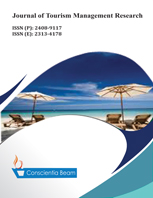Tourism and Growth in Nigeria: Application of TYDL Granger-Causality Test and Innovation Accounting Techniques
DOI:
https://doi.org/10.18488/journal.31.2020.72.132.154Abstract
The causal relationship between economic growth and tourism development, first formalized by Balaguer and Cantavella-Jorda, has been a subject of an intensive debate, extensively discussed and studied in tourism economics treatise. However, an in-depth reading of this literature suggests that, besides the fact that evidences are contentious and mixed across data, methodologies, countries and, remain at best inconclusive; country-specific studies examining the relationship within the context of African countries has received relatively little attention as the bulk of existent country-specific studies mostly focused on European, American, and Asian economies. Thus, the study empirically examines whether the rapidly developing tourism sector can effectively stimulate growth in Nigeria from the period 1995 to 2019. Bounds testing procedure to co-integration, Toda-Yamamoto and Dolado-Lutkepohl approach to causality and Innovative Accounting Techniques were applied. Empirical results reveal that tourism receipts and arrivals per capital from tourism industry can effectively stimulate long- and short-run growth, as do investments in human and physical capital, in Nigeria. Thus, apt policies such as provision of adequate securities for both foreign and domestic tourists, tax incentives to tourism related industries and hotels, investment in basic infrastructure that will enhance and accelerate tourism expansion in the country should be pursued.

